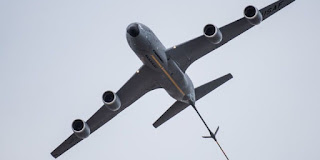The M1150 Assault Breacher Vehicle (ABV) is a U.S. military mine- and explosives-clearing vehicle, based on the M1 Abrams-chassis, equipped with a mine-plough and line charges.
Its first large scale use by the US Marines was in the joint ISAF-Afghan Operation Moshtarak in Southern Afghanistan during the War in Afghanistan in 2010 against the Taliban insurgency.
These tracked combat vehicles were especially designed to clear pathways for troops and other vehicles through minefields and along roadside bombs and improvised explosive devices.
 |
| (via bemil.chosun.com) |
The M1150 Assault Breacher Vehicle (ABV) are based on the M1 Abrams with a 1,500 horsepower engine, but fitted with a .50 cal machine gun and a front-mounted 15-foot (4.5 m) wide plow, supported by metallic skis that glide on the dirt and armed with nearly 7,000 lb (3,175 kg) of explosives.
 |
| (via bemil.chosun.com) |
The Breachers are equipped with Linear Demolition Charge System (LDCS): rockets carrying C-4 explosives up to 100–150 yards forward, detonating hidden bombs at a safe distance, so that troops and vehicles can pass through safely.
 |
| (via bemil.chosun.com) |
The ABV was developed to meet the United States Marine Corps (USMC) requirement for a new CEV that could clear safe routes for traffic and infantry through minefields, obstacles, roadside bombs, and Improvised Explosive Devices (IEDs).
 |
| Soldiers position their M1150 assault breacher vehicle during a live-fire training exercise at Fort Irwin, Calif., June 12, 2019. (Army Cpl. Alisha Grezlik) |
The ABV, often known simply as ‘The Breacher’ finally finished its development in 2008. It first saw action in 2009 in Afghanistan, before formally entering service in 2010.
In the 1990s, the U.S. Army decided it could not afford to continue developing complicated, maintenance-heavy vehicles for this purpose. The Grizzly program was cancelled in 2001, and the prototype developed never made it to the production lines. The Marine Corps however persisted and funded its own development and testing.
The main body of the final model of the ABV is built on the General Dynamics chassis that is used for the M1A1 Abrams main battle tank. Pearson Engineering of the UK provided the specially designed plow and the other mine-clearing accessories.
The ABV is the first of such vehicles to see service with the US military since the M60 based M728 CEV was retired from service in the mid-to-late 1990s, and this vehicle’s direct predecessor, the remotely operated M1 Abrams-based M1 Panther II, was retired from service in the late 2000s.
The ABV was specially designed to clear routes through battlefields heavily saturated with mines and other obstacles that would otherwise impede friendly forces from taking a designated objective.
The vehicle can create a safe lane for friendly vehicles to travel on and can physically break through, or ‘Breach’, defenses for attacking forces.
The ABV itself is based on the hull of the M1A1 model of the Abrams. These hulls were not specially constructed for the ABV, but were actually refurbished, General-Dynamics built-hulls taken from Army Surplus stocks.
To reduce costs and construction time, the ABV uses many components from the Abrams, not least, the entire power pack and suspension systems. To this end, each Assault Breacher Vehicle costs US$3.7 million.
The most powerful pieces of mine clearing equipment on the ABV are its two-line charge launchers. The model used is the M58 Mine Clearing Line Charge, or ‘MICLIC’. These devices are also known as Linear Demolition Charge Systems or ‘LDCSs’.
Line charge devices became popular in World War Two with the British ‘Conger’ and the later Cold War era ‘Giant Viper’. These devices are used to clear large areas of explosive devices or blast a path through obstacles.
 |
| A U.S. Soldier, assigned to 2nd Brigade, 3rd Infantry Division, holds a fighting position during Allied Spirit at Drawsko Pomorskie Training Area, Poland, June 10, 2020. |
General Characteristics
- Type: Military Engineering Vehicle
- Place of origin: United States
- Length: 40 feet (12 meters)
- Crew: 2 (Commander, Driver)
- Total weight, battle ready: 65 short tons
- Propulsion: Honeywell AGT1500C multi-fuel turbine 1,500 shp (1,120 kW).
- Transmission: Allison DDA X-1100-3B
- Maximum speed: 67 km/h (regulated to 65 km/h)
- Main armament: M58 MICLIC
- Secondary armament: 1 50 BMG M2 machine gun mount on top of the vehicle.
- Equipment:
- High Lift Adapter (HLA)
- Full Width Mine Plow (FWMP)
- Combat Dozer Blade (CDB)
- M58 Mine CLearing Line Charge (MICLIC)
- Obstacle/Lane Marker System (OMS/LMS)















EmoticonEmoticon